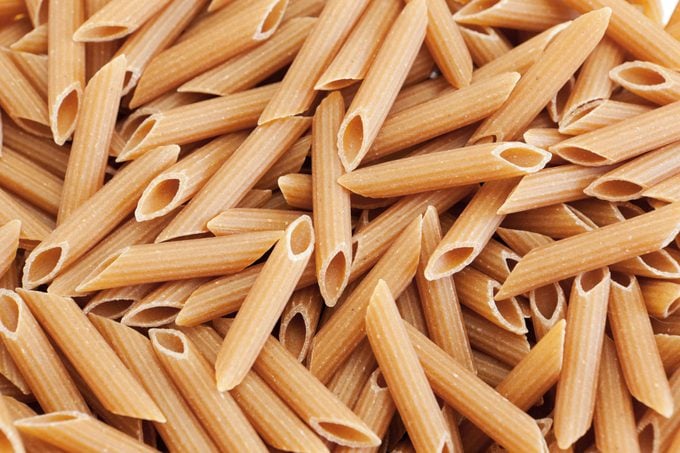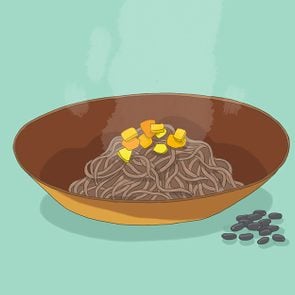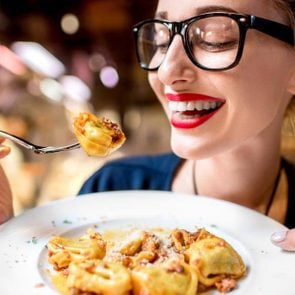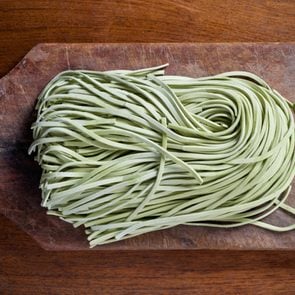Is Chickpea Pasta Healthy? 5 Nutrition Facts to Know
Updated: May 18, 2021
Regular pasta can be part of a healthy diet, but should you try the chickpea alternative? Here's what nutrition experts have to say about chickpea pasta.
Our editors and experts handpick every product we feature. We may earn a commission from your purchases.
Is chickpea pasta healthy?
Have you ever tasted chickpea pasta? If so, you’re in good company. More and more Americans are eating it these days—and for many, many reasons. For one, it’s a protein-packed, gluten-free—and lower-carb—alternative to traditional pasta. Plus, its nutty flavor makes it pretty darn tasty.
This popularity makes sense, given the extraordinary growth of plant-based diets. In fact, 28 percent of Americans say they eat more plant-based protein, according to the International Food Information Council’s 2020 Food & Health Survey.
Although chickpea pasta is popular, is chickpea pasta healthy? Here’s what health experts actually think about this pasta alternative and what you need to know before you try it out.
Chickpea pasta nutrition
Chickpea pasta is considered a minimally processed food. Yes, it’s processed because chickpeas don’t naturally come in pasta form. But it contains very few ingredients, sometimes just chickpeas.
A 2-ounce serving of chickpea pasta contains between 190 and 230 calories; 2 to 3.5 grams of fat (up to 4 percent of the daily value, or DV); 0 to 45 milligrams of sodium (up to 2 percent of the DV); 32 to 37 grams of carbohydrates (up to 13 percent of the DV); 5 to 8 grams of fiber (up to 29 percent of the DV); 1 to 2 grams of sugar; and up to 13 grams of protein, according to the U.S. Department of Agriculture (USDA).
Chickpea pasta vs. wheat pasta
“Compare that to wheat pasta, which has only 7 grams of protein and 3 grams of fiber per serving,” says registered dietitian nutritionist Jen Scheinman, RDN. Plus, chickpea pasta doesn’t contain any saturated fat, cholesterol, or added sugar. (Here’s how regular pasta can also be healthy.)
Per serving, you’ll also get 29 to 66 milligrams calcium (up to 6 percent of the DV); 3 to 4 milligrams iron (20 percent of the DV); 510 to 622 milligrams potassium (up to 15 percent of the DV); 175 to 224 milligrams phosphorous (up to 20 percent of the DV); 46 to 60 milligrams magnesium (up to 15 percent of the DV); and up to 2 milligrams zinc (20 percent of the DV), per the USDA.
“Two ounces is about one cup of pasta,” says registered dietitian Cindy Dallow, PhD, RD, owner of My Body My Life Nutrition and Fitness. “The great thing about chickpea pasta is that it’s gluten-free and high in protein and fiber, making it ideal for anyone wanting to eat less meat or wanting to lower their cholesterol levels. Chickpea pasta is also low in sodium and contains iron and potassium.”
Chickpea pasta typically boasts about 20 percent of the daily value for iron per serving. To help your body absorb plant-based iron, pair a source of vitamin C with the pasta. That can be as easy as squeezing lemon juice into a pasta salad. Or try mixing the pasta with tomato sauce or tomato slices.
Is chickpea pasta keto-friendly?
Anyone who is on the keto diet may wonder if chickpea pasta is keto-friendly. It depends. The keto diet typically limits carbohydrates to 50 grams per day. And although chickpea pasta is lower-carb, it is still full of chickpeas which contain carbohydrates. The 32 to 37 grams of carbohydrates in the typical serving of chickpea pasta could technically fit in a ketogenic diet. But it may be hard to have only 18 or so grams of carbohydrates for the rest of the day.

You get many other health benefits from chickpea pasta, too
Chickpea pasta also boasts resistant starch. “Legumes, such as chickpeas, have a type of fiber called resistant starch, which has important benefits,” says Scheinman.
“Resistant starch does not get digested by the human digestive system, so it travels to the large intestine where it can feed the healthy bacteria in our gut,” she says. “Studies have shown that eating resistant starch may have health benefits, including improved insulin sensitivity and blood glucose levels, increased satiety, and potential weight loss. It may also play an important role in gut health.”
The chickpea benefits don’t stop there. “Pulses have the potential to decrease the risk of developing cardiovascular disease, diabetes, and constipation,” says Jody Bergeron, RN, a registered nurse who works in critical care for Cape Cod Healthcare, in Massachusetts. (Here are even more health benefits of beans.)
Types of chickpea pasta to choose from
“There are two main types of chickpeas: the light-seeded Kabuli and smaller, dark-seeded Desi,” says Bergeron. The Kabuli chickpea is what we typically call the garbanzo bean. You may also see black, green, and red chickpea varieties out there. Most kinds of chickpea pastas are from the garbanzo bean. (Check out the best types of beans for plant-based protein.)
You’ll find chickpea pasta in many forms. These include rotini, penne, elbows, shells, spaghetti, lasagna noodles, cavatappi, wheels, casarecce, and more.
Because several brands of chickpea pasta exist—including Banza, Tolerant Foods, Barilla, Chickapea, Whole Foods Market, Olo Organic, and Explore Cuisine—there are many other ingredient make-ups. Some are made simply from chickpea flour or chickpeas. Others may also contain rice flour and pea protein. And yet others may include binders such as tapioca and xanthan gum.
Risks and side effects of chickpea pasta
As with any higher-fiber food, you’ll need to gradually increase your intake so your body can get used to the uptick in fiber. Otherwise, you might experience symptoms like gas, bloating, and abdominal cramping. “Start with once a week, and then increase the frequency from there,” suggests Dallow.
“It’s the oligosaccharides in chickpeas that are not absorbed,” says Bergeron. They “are fermented by bacteria in the colon that can lead to gas and bloating.”
How to eat chickpea pasta
The easiest way to add chickpea pasta to a meal? “Use it in place of pasta in any recipe,” says registered dietitian nutritionist Vandana Sheth, RDN, author of My Indian Table. “I make mac and cheese, pasta primavera, lasagna, and even fried rice.” Yes, there’s chickpea rice out there. (Try these healthy pasta recipes this registered dietitian loves.)
You can also add chickpea pasta to soups, pasta salads, and noodle bakes. “For many of my clients, just topping it with some tomato sauce and a side of sauteed greens makes this a super quick and easy weeknight meal that the whole family can enjoy,” says Scheinman.
And instead of traditional tomato sauce, you can also pair the pasta with a homemade light Alfredo sauce or even pesto. (Here are the best canned bean recipes.)
Bottom line
There’s no official rule as to how often you can eat chickpea pasta. Just be sure to make a balanced meal out of it. “I encourage my clients to enjoy half their plate with veggies, a quarter with lean protein, and a quarter with carbs,” says Sheth. (Here’s a healthy spaghetti recipe to try from a registered dietitian.)
An example: Chickpea pasta, combined with roasted salmon, broccoli, and grape tomatoes. Chickpea pasta counts as a protein and a carbohydrate. “When you choose chickpea pasta, technically, you can fill half your plate with pasta and the other half with veggies,” she says. Now, see the top plant-based food trends for 2021.























